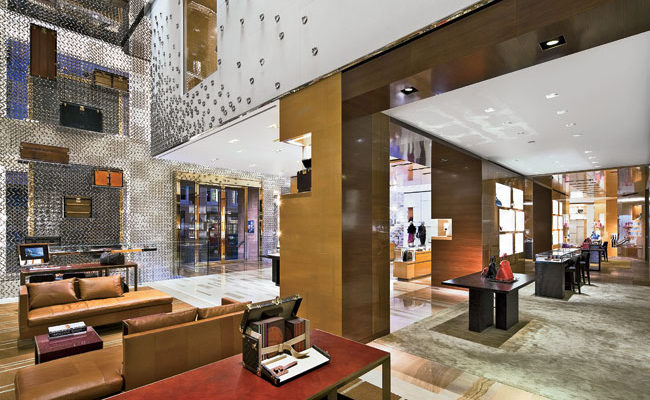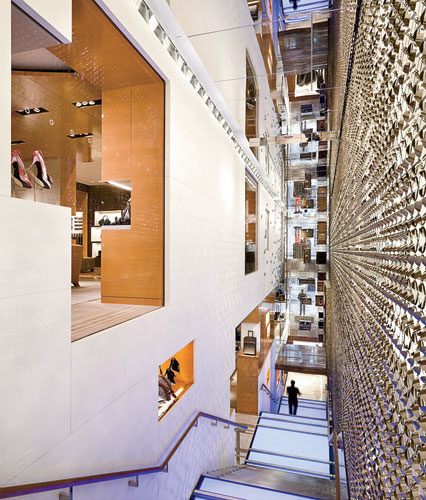London
Standing by the handbag bar at the Louis Vuitton Maison (House of Vuitton) on New Bond Street, in London’s Mayfair district, one can observe a strange kind of tourism. The most multilingual of London sales assistants are available to sell a $4,000 handbag to just about anyone.
Wherever these tourists come from, you can bet there is a Louis Vuitton (LV) closer than London. But the new store, with 16,146 square feet of retail space, is intended to be unique. “New Bond Street is the most high-end shopping street in the world,” explains New York City—based Peter Marino, the project’s architect. “We all thought that with the recession it would crack, but it never stops.” This comment is supported by recent reports in the U.K. press that, despite the ailing British economy, when consumers want an expensive handbag, they buy it in London. Even the “wave of new money from Asia and the Middle East comes to London,” says Marino.
Building for such elite consumers comes with responsibilities. “These are exceedingly well-off customers,” says the architect, who has been working with the client since 1996. The environment necessary to attract this clientele must evoke the brand’s version of luxury, relate to the city (or at least a posh version of it), and to the structure. To create the London Louis Vuitton Maison — conceived as the home of a collector — Marino and his design team gutted and unified two buildings, one Georgian and the other vaguely Art Deco. Outside, he integrated them at the street level by resurfacing the facade with a blindingly white portland stone. A city ordinance prohibited going above that.
Inside, well-heeled patrons are treated to a grand double-height atrium with gold titanium-plated shelves displaying the company’s signature luggage. To reach the “maison” from the entry, they must cross a bridge clad with stalattite stone, meant to be a camp reference to a drawbridge. This overpass spans a full-height void sliced by the shop’s main vertical thoroughfare — a “bling” stair with treads composed of limestone and glass strips animated by color-changing LEDs and media streams.
Like a gilded cage, the glittering volume features window walls lined with a curtain of flower-patterned stainless-steel mesh and a mirrored ceiling that expands the space infinitely upward. Opposite, a limestone-clad inner structural skin, punctuated by openings to bring in daylight, encloses much of the actual sales area to create a more intimate experience.
Marino divided the ground floor into rooms dedicated to leather goods and accessories, covering a central cashier desk with a light Aniegre-wood-veneer canopy. Darker timbers line the walls of glamorous rooms at the back where fine jewelry and watches are displayed amid satiny surfaces of French lacquer veneer.
Down a few steps, the tone is lighter both chromatically and atmospherically. Here, a circular costume-jewelry shop features playful LV-branded space-age mobiles and a sculpture, titled Kiki, by Japanese artist Takashi Murakami — one of a collection of art pieces installed throughout the store. Across the way, in a small boutique with a similarly round footprint, rows of sunglasses are reflected in a palpitating dichroic-glass ceiling. Between these, a casual “Bag Bar,” complete with stools, allows customers to sit and relax while they select purses from backlit moving display boxes.
The lower level houses a men’s clothing department, surfaced in dark brown tones and appointed with clubby armchairs and a large artwork, called Paws, by Gilbert and George. On the third level, intricately detailed combinations of materials distinguish women’s ready-to-wear, as well as an exhibition of historic garments. Toward the rear of this floor, Marino positioned an installation appropriately dubbed Trunk, by British art scion Damien Hirst, at the entrance of the Maison’s “Libraire,” a “curated” bookshop with a vaulted stretch ceiling backlit by LEDs.
Of course, no true luxury establishment is complete without a private suite. Marino’s take is “The Apartment,” on a fourth level not accessible by the glass stair. This residencelike series of rooms is where the most “I” of VIPs are served in the comfort of a private sitting room. “It’s an exciting idea — 2,200 square feet with no merchandise,” Marino says, noting that he hasn’t seen the numbers. But it must be working. He has just been commissioned to add similar “apartments” to LV’s New York and Shanghai stores.
Many architects involved in retail feel that their work is not taken seriously by their peers. Perhaps the others should be jealous. The budgets, speed, and glamour of this type of project are often at a level most architecture never approaches.
Marino’s commercial insights are impressive. And while the aesthetic archetypes of luxury, as elaborated in 1920s Paris, have not really advanced with the century, Marino’s business acumen and flair for materials and detail make him one of the most effective practitioners in the genre.
Evening Standard Architectural Review Architects’ Journal.
Location: London
Completion Date: May 2010
Gross square footage: 16,150 sq. ft.
Architect
Peter Marino Architect
150 East 58 Street New York, NY 10022
T: 212 752 5444 / F: 212 759 3727
PeopleOwner: Louis Vuitton UK Architect: Personnel in architect's firm who should receive special credit: Architect of record: Wintersgill Interior designer: Peter Marino, FAIA Engineer(s) Mechanical Engineer: J.E. Evans Associates Consultant(s) Lighting: Arup Lighting General contractor: Powells Group; Marzorati Ronchetti, Italy (millwork) Photographer(s): Renderer(s): |
ProductsSolid Surface Material: Corian ( used on the ground floor illuminated ceiling and wall adjacent to the stair as well as on the illuminated panels on the Bag Bar.) Stretch Ceiling: Barisol (used for the vaulted ceiling in the books department as well as for the back-lit image in the Ground floor cash area.) Decorative Wall Surface: Kinon ( used for the wall finish in the Costume Jewelry department.) Decorative Plasters, throughout: Armourcoat, UK Stone Flooring and Limestone wall at stair: L’Europeene de Marbre (EDM), France Portland stone supplier (façade): Stone Firms Limited, UK Dichroic Glass - moving ceiling plane in the Sunglasses room: Schott Hammered metal floor in the Sunglasses department: De Ferranti, UK |










